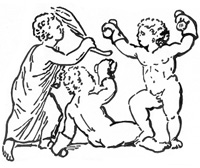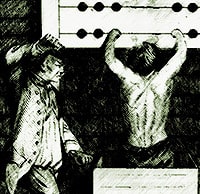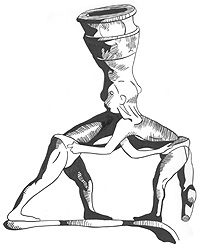A fellow writer asked me recently if I could give her tips on unarmed military combat for a piece she is working on. This is actually a huge, diffuse subject, in which military thinkers and personnel are generally not interested, as it has from zero to the tiniest influence upon any conceivable tactical situation. The recent Krav Maga craze—which is marketing based, and has nothing to do with IDF troopers elbowing jihadists in dark rooms—has given the impression to many outside of the combat arts world that military personnel possess some special empty hand skill set which is somehow different or even better than that employed by other types of combatants.
Historical Notes
As far back as the 3rd Century B.C. military men were ridiculing any concern with empty hand fighting as beneath them! In an age when military men hacked each other to pieces at arm’s length, they could have cared less about unarmed fighting, as they knew it to be all but useless in a military context. Over the ages military establishments have either ignored the empty hand question, or have farmed it out to specialists, or made it the personal duty of officers.
For one example of the later let’s take the British military during the Zulu Wars of the late 1800s. The foot soldiers were recruited from a stunted and malnourished population living on starvation rations, and stood about 5-foot 6-inches and weighed around 140 pounds.
The Zulu warriors they fought were drawn from a well-nourished beef-eating population and stood about 6-foot and weighed in between 160 and 180 pounds, with some chiefs and famous warriors being of goliath proportions. The Zulus supplemented their thrusting spear and shield training with wrestling and stick fighting. These were formidable hand-to-hand warriors. As with most warrior cultures throughout history, the Zulus concerned themselves with weaponry and grappling; grappling being the way to obtain a weapon once one has lost his own, as well as a way to neutralize an enemy’s weapon once one has lost his. It is exceedingly rare to see any concern with empty hand striking as it is largely useless in armed combat.
The man in charge of the ‘physical education’ of the British soldier was his officer, a well-fed spoiled rich boy who stood 5-foot 10-inches and weighed in at about 170-pounds. This man would wrestle with pro wrestlers that he and his rich fellows would sponsor at home, as well as spar with famous prize-fighters. [Teddy Roosevelt did this in the white house when he was president!] This officer would then wrestle and box with his entire unit, lining them up and beating their emaciated asses, just like the prize-fighters had worked him and his rich friends over. The wrestling was intended to develop one’s ability to maintain his footing and his hold on his all-important rifle-bayonet, a fearsome weapon even when unloaded. The boxing was purely psychological conditioning, intended to fill the soldier with a tenacious confidence that he could endure the worst.
When the Brits were overrun in one battle, and their ammunition ran out, the Zulu’s suffered horrendous casualties in hand-to-hand combat. It was all about the bayonet. Even with empty guns, it was still the gun that mattered. We cannot forget, when writing unarmed combat scenes involving military combatants, that they are all indoctrinated—a most potent indoctrination, as it is built on a natural primate impulse to seek a weapon—to fight with empty hands only as a way to access a weapon or to deny enemy access to a weapon. There are patchy records of military men striking with fists when in desperate straits, though this is more an act of final defiance than a tactical option.
Nonfiction Sources
The Military Book Club has a large selection of modern combat memoirs. The only one I know of that covers hand-to-hand is a brutally gripping story told by an author whose name I have forgotten. The book is titled House to House. I gave it to a young man to convince him not to enroll in the military.
Film Resources
I have only seen a few hundred movies in my lifetime. That is scarce I know. I mostly avoid movies because I have rarely seen realistic violence in the vast majority. It is hard for me to suspend disbelief when no combatant ever does anything that makes sense. Viewing Rambo movies with an experienced soldier elicits groans, as does watching Saving Private Ryan, and realizing that those guys would all be dead long before they found Mat Damon, based on their high profile line of march cross country. Of the dozens of martial arts movies I have seen I have never seen anything remotely realistic or functional.
Below is my short list of realistic violence in film:
For military action I like Battle Los Angeles. I know its sci-fi, but the combatant behavior and unit cohesion is authentic.
The only realistic knife use in film is to be found in The Hunted, with Tommy Lee Jones and Benicio del Toro.
The latest Bourne movie, did have some realistic if overdone FMA applications in a close quarter combat scene.
The only realistic empty hand combat I have ever seen in film is by the Bruce Willis character in Twelve Monkeys.
Using film as a combat model assures fakery. A film must appeal to the ignorance of the audience concerning such matters, therefore perpetuating that ignorance by way of reinforcement. The best two examples are the perennial saloon brawl in classic Hollywood westerns, in which nothing that ever happened in the old west happens—and does so with ritual frequency—but is rather a fictional construct of whole cloth based on mid 20th Century Anglo-Saxon protestant mores. Another example of total Hollywood concoction is the horrible film starring Gerald Butler, Olympus Has Fallen. The knife action and the apex scene with the Korean badass is the worst possible hand-to-hand horseshit imaginable.
The best examples of intractable Hollywood fakery are the iconic American image of the fist, and the evil antisocial image of the blade in our wife-beating gun culture. [This deserves an entire article.] Many times in film you will see the fist—and since the advent of Chuck Norris the shoe—defeat the knife. There are ways to defeat a knife-armed aggressor when unarmed, but only when one does not punch and kick, and only if the knifer cannot fight at all, and the unarmed party is an elite combatant. If you gave me one thirteen year old girl to match against every Krav Maga instructor in town, or even against every UFC world champion, and gave me a week to train them with military knives, my team of female children would win any such team meet against the most formidable men on the planet. Killer assassin middle-school girls, I kid you not! I would bring in 12-year-old black girls from West Baltimore as sparring partners.
Warriors know that the weapon rules and the empty hand option is ether an off-duty game to exercise the mind and spirit, or is a desperate act of defiance that hopefully buys a comrade-in-arms a chance to survive the action. Empty hand against knife or gun is essentially throwing yourself on a hand grenade.
Military Personnel in Empty Hand Combat
The men below are people who I have had in-depth face-to-face conversations with. Some of them I have trained. Some of them I have trained with. It is a feature of the warrior-identified military man to want to carry his warriorhood into private life. He will then typically seek out training opportunities with people like myself, as he only received enough empty hand training in boot camp and advanced training evolutions to gather the possibilities, not to become effective.
You see, he knows what effective feels like, because he is effective with his weapons, and can intuitively sense that he is not a very survivable unarmed combatant. Mind you that the ego of these military people has been engaged, and they are brainwashed into feeling themselves to be unarmed forces to be reckoned with. This is just a military mind-screw to prop up self-sacrificing levels of morale. The empty hand training received by most military people is a joke, and the independent-minded and aggressive members of the service know this.
The respect currently given to the IDF’s Krav Maga system is based on the fact that it is a deliberately evolved form of self-defense for military personnel. In the early 1970s martial arts magazines were carrying articles on this system’s development, which featured scenario-based training to prepare a bunk prone soldier from being abducted by terrorists. The fact that IDF personnel were likely to be targeted by terrorists while off duty made the IDF take the unique measure of developing an empty hand survival set for its soldiers. The system itself is in fact nothing special, with no unique techniques, being a hybridization of methods borrowed from various martial arts and sports.
The Real Deal from 1952 thru 2013
I will take you through interviews with some military personnel in chronological order of their service.
Uncle Bernie
As I began wrestling and boxing in junior high and discovered that World War II and Korean war era soldiers were taught Judo as an empty hand set I put this question to my good old Uncle Bernie, a veteran of the Korean war, who loved shooting ‘ChiCom bastards in the head’.
“Judo! Nothing but Jap bullshit. We wiped ‘em out in WW-Two, and were saving their Jap asses in Korea—so many goddamned Chinks they could have swam to Japan like a chain of floating ants. We stacked those yellow bastards up! An American soldier is not a soldier without firepower. That is the whole premise, superior firepower: head shots, torso ventilation bleed-out. Bare hands? Are you nuts kid? You can’t wrestle a goddamned army of rabid yellow chimps. Fuckers shot me in the ass and I never forgave them—head shots all day long. Every deer I shoot is a Chink. That bear there [pointing to the bearskin rug in his living room that I used to curl up on to watch westerns with him] was a goddamned Rooski!” Then pointing to the TV action, he groused, “And this Hollywood bullshit drives me crazy! Goddamned redskins riding circles around you and you’re not dropping the horses? Make infantry out of them!”
Uncle Bernie had the common prejudice against empty hand action and any impractical killing method common among combatants in major military actions.
Big Dave
This man demonstrates the only real utility of empty hand combat for participants in major modern actions, as a recreational venting mechanism to stave off a psychotic break. Dave was an amateur boxer and pro wrestler, an enormous alpha male with deep racial hatreds. He got into a bar fight with a black soldier from the 24th Division in Korea. The other man stabbed him in the kidney with a switch blade. The blade stayed in, plugging the fatal wound, while Dave proceeded to cripple and maim his rival for the affections of a Korean hooker. Dave fought MPs [military police] for fun when drunk, and considered it a point of honor that it never took less than 4, and as many as 8, baton-wielding MPs to subdue him.
A reading of Richard Marcinko’s Navy SEAL memoirs will unveil a similar propensity for fighting locals and members of rival service arms in off-base bars up into the 1980s.
Banno
Banno was a member of the 101 Air-mobile Division; the famed ‘Screaming Eagles’. He saw combat during the Tet Offensive in Vietnam. He began practicing karate after discharge as he had been impressed by the ROK Marines, who the NVA and Viet Cong feared for their martial arts skills. After his return to the States he worked as an assassin, enforcer, and debt collector for a Chinese heroin distributor. He killed at least two men with his hands in this capacity. Although his stated empty hand art was ‘Korean Karate’ he was immensely strong and preferred to grab the ‘victim’ and head but them, ‘turning their face to pudding’. I once nervously refereed an argument between Banno and Tango, an 82nd Airborne trooper, as each insisted that the other sucked larger enemy penises. They finally agreed that the ‘Marines’ were the most traitorously fellatio-fond branch of the U.S services, and proceeded to get drunk and really scary.
Jan
Jan was a Vietnam vet who served with the ROK Marines, and assured me that the fearsome reputation of the famed ‘Tiger Brigade’ was well-deserved, and that enemy units would not even attempt to overrun ROK positions, as every ROK soldier was essentially a pro level karate man who did not care if he was armed or not. This mystique was cultivated and reinforced by the ROK, when they toured villages and gave martial arts demonstrations to cow the population. Jan became a high level TaeKwonDo instructor.
Tango
Tango served in the 82nd Airborne in the 1980s and laughed out loud when I asked him about military combatives as taught to this elite unit. He fairly barked, “They teach you to get in a crouch and scream, ‘Kill! Kill!!’ what bullshit! The guys that went on to Ranger and Special Forces school were no different. We maneuvered against them. Their movement was better, and the Special Forces guys had language skills and medical training and shit, but they are no better at killing. The DELTA Force guys—those are scary motherfuckers! You let them ahead of you at the chow line. Those are all dangerous guys twenty-four seven. They’re trained to shoot pregnant women and kill with their hands if need-be. But with marksmanship skills like they have, there is not much of a ‘need-be’ out there.
“I wanted to be able to deal with the Germans and the Panamanians that hated us being stationed in their country, and to be able to handle myself while drunk. That’s why I took up boxing in the army when I was stationed in Italy. But when its time, when they loaded us up on the C-one-thirties to drop into Lebanon after the jarheads got greased in that barracks bombing, nobody is thinking hand-to-hand, not even knife. I probably packed two-hundred pounds of ordinance—a walking arsenal. Karate, are you kidding me?”
Keith
Keith was a Marine who had to defend himself from a group of soccer hooligans. The Marines had taught him nothing applicable to being unarmed in combat, except what he learned on the Marine Boxing Team. He leveled the thugs with punches. Throughout history, unarmed arts taught to servicemen have largely been focused on morale building, with the side benefit that soldiers and sailors stationed in hostile areas might defend themselves when attacked by the locals while out drinking and whoring.
Maneo
This man is a Baltimore City bus driver. He was a Special Forces veteran who had been stationed in Korea, and had been admitted into a Korean martial arts brotherhood on condition that he tour for them as a kick-boxer on the Pacific Rim circuit. Here we are back to the Korean influence on American service arts. Chuck Norris learned Korean martial arts while stationed in the Far East. Maneo was largely interested in martial arts as a warrior pastime, a spiritual development tool that would feed his craving for action in a quite sector where soldiers just sit waiting for Doomsday. He was also encouraged to train as an honorary Korean when he found it would open up dating opportunities with the best looking Korean babes, as opposed to employing hookers as most U.S. servicemen do.
Maneo is 6’ 1” and appears to be carved of ironwood. He ‘commands’ the male bus passengers to behave, and they do. When he saw me board with my fencing mask and stick-fighting gloves he grilled me about my experience. He had me stay on board until the end of the line so he could show me the ‘through-and-through 7.62 millimeter’ round he took in the right oblique muscle when he was providing muscle for a DEA operation in one of the United States’ undeclared wars in Latin America. He then took off his hat and showed me a high caliber bullet graze that sliced through his scalp, leaving point-blank muzzle burns. This is what he said.
“Here I sit, having survived three combat tours in undeclared wars as a special operations weapons specialist. On the streets of Baltimore I face death! One night this hood-rat steps up to me and places the muzzle of a three-fifty-seven revolver to my forehead. Thank God it was a revolver and that he did not have it pre-cocked. When he went to cock it I stripped as per the close quarter drill. Actually, he could have just squeezed the trigger. That make did not need to be cocked. After that it was joint and spinal destruction time. He’s living in a spacesuit now. But even with the training, even with the prize-fighting that honed my close quarter instincts beyond the drill, I would have died if it was an automatic or that idiot bag of meat had known just to squeeze.”
Here, with Maneo, the new breed of small-action special operations warrior, we come to the true badass, who has the natural ability and full contact competition experience to make empty hand work against weapons, and, who has pro level ability in an empty hand versus empty hand situation. Recall though, that his deeply ingrained stress-honed doctrine is to go to a weapon at first opportunity.
Eugene
I was prepping to fight Damien Kestle in a set of 15 machete duels in 2009 in Virginia Beach, which included a pipe versus chain fight. I shared my dressing room area with Eugene, a former Navy SEAL from New England, who was an empty hand tactical instructor for current Navy SEALs. I had just read a memoir by a SEAL who had survived a terrible ambush in Afghanistan that claimed two full teams. Eugene knew them all.
He expressed great interest in what we were doing, and had just won his MMA fight by arm-bar. He was built like a Greek god and could have killed me with his bare hands in seconds. He confessed that he was not really equipped to deal with a knife-to-knife or empty hand versus knife situation, and reiterated that military empty hand was just a way to a weapon. I told him about a fellow coach of mine who once watched his teenage students toy with a ‘big badass Navy SEAL.’ Eugene smirked, “The whole SEAL mystique is something of value, so long as you do not let it go to your head in a tactical sense. I always stress that we are all pretty much meat without a weapon. I compete like this so that I at least will have the physicality to make close-quarter action work decisively at full-speed. You can’t just train that. You have to do it. I’ll be ringside.”
An hour later Eugene was ringside cheering on Damien [who I had just ripped open with a machete from nipple to short rib] as I flew through the air with a chain wrapped around me and groggily tried to get to my feet as my arm began bending in a way it was not meant to bend and a leg pinned my chest. Eugene, the Navy SEAL instructor, led the cheering session that roared in ecstasy and slapped the ring apron as Damien made something they have nightmares about not being able to do work against a vicious old boxer trying to spilt his helmet open with a pipe—a weapon that ended up I don’t know where. The point behind that story is that hand-to-hand is so uncommon in military situations that such close-quarter combat is a subject of keen interest but little experience for most military combatants.
You might notice that as military action by the U.S. services has become smaller scale over my lifetime that the empty hand fighting ability of special operations types of soldiers is taking on many of the dimensions seen in the UFC cage. I might suggest viewing MMA fights by the smaller men and women when constructing a fight scene, keeping in mind to edit out any and all kicks to the head and limiting the action to about 15 seconds, as military combat situations call for desperate measures. Such combatants will be less cautious than the MMA fighters and ‘just go for it’ forcing a quick resolution instead of playing for time. Military personnel in sci-fi settings are going to be of this type, as with increased technology, the only soldiers out there in combat will be what we presently call special operations soldiers.
Jon
Jon is an Air Force MP [military police] who was recently in a supervisory position at a base in Afghanistan. In our brief recent conversation he reiterated many of the points made chronologically above. First, he, like every U.S. serviceman I have talked to on this subject, is in awe of the Korean military man’s empty hand ability and cross country conditioning. The arts employed by the Korean military are TaeKwonDo and Hapkido. A writer would be well-served to research self-defense demonstrations by the top men in these arts, particularly Hapkido.
The other major point he made was how much danger normal base personnel were in at the hands of drunken and psychotic special operations soldiers. Look above, and put Maneo’s skill set [TaeKwonDo, Hapkido, Jiu-Jitsu] in the hands of Big Dave and Banno. That is quick and nasty on steroids. Also recall, that most military personal are not even combatants, and certainly possess no warriors skills and ethos. Over 80% of current personnel are not intended for a physical combat role.
In unarmed terms, characters like Big Dave, Banno and Maneo are like wolves. By way of comparison the vast majority of personnel are essentially toy poodles. You might think of the base situation Joe was invoking as analogous to a Pet Smart habitat full of poodles being forced to accommodate these wolves. This was the 1960s IDF fear; that some terrorist wolves would get in among their rear-echelon poodles. In that sense MPs like Joe are like the big working dogs that were bread to shield lesser domestic animals from the wolves. The relative nature of canine combatants is to my mind, the easiest way to relate this.
A Comparative Empty Hand Military Matrix by [Canine Metaphor]
Each empty hand combatant type is assigned a relative combat value and a canine equivalent in brackets. Note that with firearms there is less disparity between types. Much of the empty hand disparity is really just a measure of physical ability based on training requirements, with the actual functional possession of a high level empty hand skill set only present at the high end of the matrix.
0. REMFs: Rear Echelon Mutherfuckers—the appropriate term according to Colonel David Hackworth—which is the bulk of any modern military, basically combat support personnel [toy poodles]
1. 2nd Class troops, like guard, reserves, and sailors [terriers]
2. 1st Class troops, like regular army, [Lassie]
3. Military Police [Dobermans, K-9 shepherds]
4. Elite combat troops such as marines, mountain infantry, and airborne [pit bulls]
5. Special operations troops, such as marine recon, army Special Forces, army ranger, British SAS, etc. [coyotes]
6. Elite Special operations troops such as Navy SEALs, army Special Forces weapons specialists, and DELTA Force [wolves]
Note that this looks less like a competition bracket than a food chain. A Navy SEAL in a below decks life-and-death fight over some treason or another against a simple sailor, is a 6-to-1 fight.
Remember, no head kicks, no spins, and do not forget to rip out eyes, smash the testicles and pound faces and heads into hard surfaces, good guy or not. Watch 12 Monkeys. The scene where Bruce Willis beats the pimp with the phone: that is the military mentality. Fighting like a ‘good guy’ is heinous bullshit, and is less admirable than marrying a used up hooker from the slums of Seoul.











Great article and many thanks James! Also thanks for the name of the two characters I am writing now—the lady is now Tango and the alien is Djan ....
Glad to be of some help. If this is a sci-fi setting beyond earth, that will involve aliens, recall the Korean influence on American arts. An alien race would have their own tradition—maybe they prefer kicking to punching—and would fight differently than a human opponent. The simple solution would be to assign an art [let us say Akido [Steven Segal] to one nationality or race, and another art, let us say capoeira, to the opponent. Look up demonstrations of these arts on YouTube. You might even see fights. For instance, you can find a dozen Wing Chun versus TaeKwonDo fights on YouTube, and you will notice further that all of the Wing Chun guys are stocky and the TKD guys lanky, so could use your character's body type as a reference. Just call these arts something else in your setting. For instance in your Tau4 series the warriors of Sephis are renowned for hand-to-hand combat. It would follow that various other peoples and militaries might employ Sephid warriors as instructors for their troops in close quarter combat.
One thing I did leave out. Military combat takes place without hand gear. The doctrine followed by most arts when striking without weapons is to target soft areas [gut/ throat]with hard striking surfaces [knuckles, elbows], and to strike hard surfaces [the skull] with a softer part [the palm]. You're not knocking a hole in the head but using the impact to the head to shock the neck and shut down the nerve traffic from the brain to the body.
Good luck and have fun.
PS: Tango is my brother's nickname—I can't wait to tell him he's a template for a sci-fi babe-trooper!
mr la fond,in fighting edge you refer to the combatives trained person as a dangerous critter similar to the experienced untrained combatant.my question is,if there is any value to practice the ww2 combatives(especially without a partner)for self defence,not only in the context of taking preemptive action(hitting first)but in the context that you have been attacked first,taking account the fluid and unpredictable nature of any real fight.many thanks for all your articles
Absolutely Alex.
Military combatives are developed for desperate situations. If you are being stalked and need to preempt, they are generally appropriate [mechanically and behaviorally, but perhaps not legally]. If you have already been attacked they are generally ideal, and have evolved much since I wrote that book.
the best example of how karate can be applied as a military style combative method is from Peyton Quinn's first paladin Book, in which he was attacked by two guys who were armed with blunt weapons. By the time he knew that he and his buddy were being ambushed his friend was out and he was injured—but he took care of business.
Marc MacYoung and I are more on the behavioral side of things, avoidance and body language. I have to say Quinn—of the Paladin authors—is the most stress-based, closest to military combatives.
Practice your solo combatives at the base of a stairwell, in your bathroom, or in a narrow hallway. Make it a sensible type of shadow fighting. visualization is key to unlocking your shadow-fighting rhythm. I coach boxing and stick fighting right beside a karate instructor, who preaches visualization as the primary aspect that gives meaning to karate forms. It is the same with boxing, and certain hard karate methods makes a good model for WWII military combatives. I will do an article on it some day.
Take care over there.
by the way the best hand to hand combat scenes depicted in a movie,in my opinion is in 1994 film by lee tamahori'once were warriors', very simple explosive believable sequences.other than that everything else that i have seen is laughable as real world violence and fight or combat goes.
I will have my geek squad look this movie up.
Thanks for the heads up Alex.
I am familliar with the tale from mr quinn's "bouncer's guide to baroom brawling".you're right, perfect example.It is very motivational for me to hear your suggestions for training.Thank you very much.Perhaps it will be very helpfull to many readers,an article about behavioral aspects,especially when you're challenged or threatened.for example which are the best ways,to respond to the age old and universally asked question by all aggressors,of "WHAT ARE YOU LOOKIN AT"and the specifics of posture,eye contact,tone of voice,attire,hand movement etcetera...
They say 'what are you looking at?' in Greece too!
Wow, it seems jerks are more universal than I thought.
I'll do a piece on that soon.
Thanks.